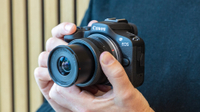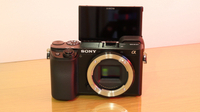Digital Camera World Verdict
With a its 20MP sensor, excellent in-body image stabilization and flip-down tiltable monitor, the Olympus OM-D E-M10 Mark IV has plenty to shout about. It captures 4K video and has the attractive styling that made the Mark III so attractive to consumers. The OM-D E-M10 Mark IV has the vintage styling that's in such high demand today, and packs a lot of power into a very small and very affordable little camera. We can recommend it just as strongly today as when it was launched back in 2020.
Pros
- +
20MP sensor delivers good image quality
- +
Excellent stablization
- +
Wide range of MFT lenses
- +
Flip down monitor
Cons
- -
No mic port
- -
Plastic build
Why you can trust Digital Camera World
The Olympus OM-D E-M10 Mark IV is sleek, stylish and unbelievably lightweight. With an upgraded 20MP sensor and improvements made to the autofocus, this Micro Four Thirds camera is impressive even in 2024.
When it was launched, Olympus was in the middle of a high-profile sale and a future rebrand, but the arrival of the Olympus OM-D E-M10 Mark IV shows that it was very much business as usual for the imaging company. Now, a few years down the line, the Olympus brand is gone but the OM System brand has taken its place – and the trusty OM-D E-M10 IV is still on sale, and just as compelling today as it was back then.
With some interesting improvements made over its predecessor, the Olympus OM-D E-M10 Mark III, this camera is perfect for beginners and budget buyers, and still ranks as one of the best Olympus cameras ever. We still recommend it as one of the best cameras for beginners, and best travel cameras too.
We had great affection for the E-M10 Mark III, as it’s a fantastic little camera with plenty of useful features to crow about. Thanks to its compact body, 5-axis image stabilization and 4K video capability, it sat squarely atop our best travel cameras guide for quite some time.
Of course, a lot has happened since the OM-D E-M10 IV was launched. OM System has also released the beautiful PEN E-P7, though this lacks a viewfinder and is not available in all territories. And there's also been the OM-5, essentially a reboot of the OM-D E-M5 Mark III. These are nice cameras, but a little more advanced and more specialized. The E-M10 Mark IV remains cheaper than both of them but, in its own way, equally desirable.
• Read more: Olympus OM-D E-M10 Mark IV vs Mark III vs Mark II
So, with an updated 20MP sensor and improvements made to the Continuous AF focusing mode, could the Olympus OM-D E-M10 Mark IV still be the perfect camera in 2024 for those looking for something compact, yet powerful?
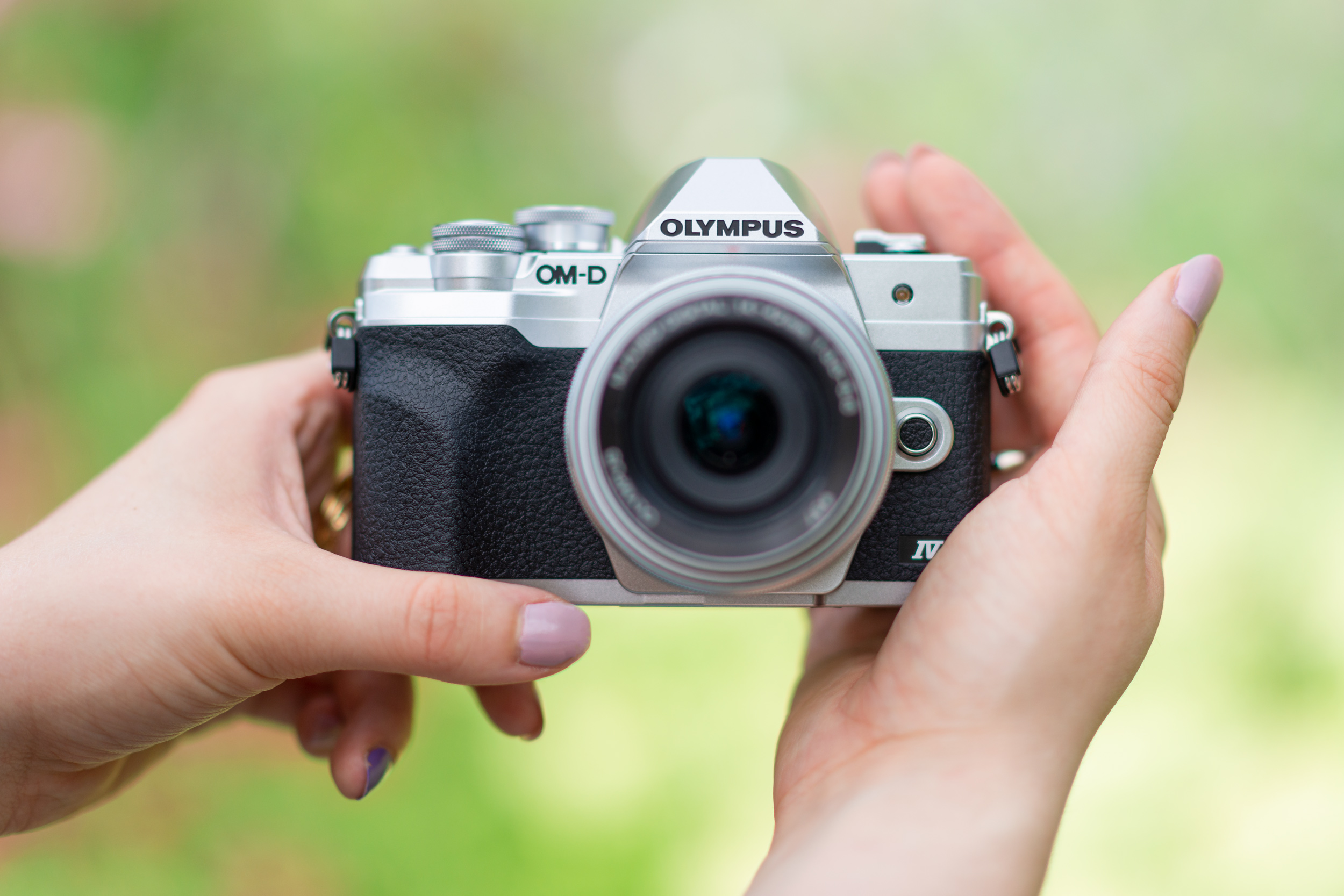
Olympus OM-D E-M10 Mark IV: Specifications
Sensor: 20.3MP 4/3” Live MOS sensor
Lens mount: Micro Four Thirds
Image processor: TruePic VIII
AF points: 121 point Contrast Detection AF system
ISO range: Low (approx. 80) - 25,600
Metering modes: ESP light metering, Spot metering, Centre weighted metering, Highlight, Shadow
Video: 4K at 30p, 25p, 24p, Full HD at 60p, 50p, IPB (F,N)
Viewfinder: EVF, 2,360K dots
Memory card: SD/SDHC/SDXC (UHS I/ UHS II)
LCD: 3-inch tiltable touchscreen, 1,037K dots
Max burst: 8.7fps high, 5fps low
Connectivity: Wi-Fi, Bluetooth
Size: 121.7mm x 84.4mm x 49mm
Weight: 383g (body only, including battery and memory card)
Olympus OM-D E-M10 Mark IV: Key features
One of the key new features for the Olympus OM-D E-M10 Mark IV is its 20MP Live MOS sensor, which is a boost from the previous generation’s 16MP sensor. This brings the E-M10 series in line with the latest OM System cameras, which share the same 20MP resolution (though the newer OM-1 and OM-1 Mark II have a faster and more advanced stacked sensor design).
The Mark IV also features a compact in-body image stabilization unit with up to 4.5 EV steps of compensation and 15 fps high-speed sequential shooting.
4.5 stops of shake reduction doesn't sound much compared to the 6, 7 or 8 stops claimed by some of the best mirrorless cameras, but we've always found Olympus stabilization to be consistent and reliable, which is not always the case with other brands.
The E-M10 IV also gets improved continuous AF precision for moving subjects. Meanwhile, the Face Priority/ Eye Priority AF is able to focus on faces in profile or looking down, which should help ensure that users can capture sharp portraits even at unconventional angles.
The Olympus OM-D E-M10 Mark IV also has a variety of shooting modes, including AUTO, SCN (Scene), AP (Advanced Photo) and Art Filter. The AP mode brings challenging shooting techniques to a beginner’s level, such as panoramas, HDR and more. Meanwhile, the Art Filter mode includes a variety of filters that, while not particularly useful for more serious shooting situations, are great fun for families and friends to play around with.
The Mark IV retains the 4K video capabilities of the Mark III, but has the added advantage of a tilting LCD monitor that can flip down 180º for self-facing video shooting and vlogging. Meanwhile, as you would expect in a camera like the Olympus OM-D E-M10 Mark IV, there is Wi-Fi and Bluetooth built into the camera body as well.

Olympus OM-D E-M10 Mark IV: Build and handling
Just like its predecessor, the Olympus OM-D E-M10 Mark IV is incredibly lightweight and compact. However, Olympus has managed to shave 27g off the Mark IV, making it even more portable. The trade-off with a light camera tends to come down to the body material used to construct it. The Mark IV is made out of plastic, compared to the metal body of more expensive cameras, such as the Olympus OM-D E-M1 Mark III.
Externally, the OM-D E-M10 IV looks very similar to the previous Mark III version, retaining the same vintage styling and ergonomic dials. Speaking of the camera controls – the power switch is easy to find, even when you’re not looking directly at the camera. It slides to each position easily, with just the right amount of resistance. In a clever design quirk, you can slide the power switch past the ‘On’ position so that it’s facing forwards in order to pop the flash up.
Meanwhile, the right side of the top of the camera has three dials. The first is the mode dial, which enables you to select which shooting mode you want to work in, including Manual, Aperture Priority, Shutter Priority, Auto, Video and more. The other two dials can be used to select settings such as aperture, shutter speed and exposure compensation. Each dial is large enough to be easily found without looking, but compact enough that it fits in nicely with the stylish design. Adjusting the dials is pleasantly ergonomic, with each dial providing just enough resistance to prevent it from being accidentally knocked.

Olympus OM-D E-M10 Mark IV: Performance
One of the main aspects of the E-M10 Mark IV we wanted to test was how well the continuous AF worked. With many reviews reporting that the Mark III has trouble retaining focus on moving objects, and the promise of an improved C-AF performance in the Mark IV, we were curious to see just how much difference there would be.
Fortunately, we were pretty happy with how the camera performed. The autofocus was fast, responsive and mostly able to keep up with our model as she ran towards the camera. The only time the focus began to slip was when the model came within a meter of the camera. However, the amount of times that you’d realistically be using Continuous AF on a subject within a couple of meters of you is likely pretty low.

The 15fps sequential shooting felt nice and speedy, which was handy when capturing fast-moving subjects. The Silent version of the Sequential High burst mode also felt appropriately responsive – and was particularly useful when photographing the local wildlife up close.

We were also pleased to reap the benefits of the new 20MP Live MOS sensor – which is a welcome upgrade from the Mark III’s 16MP sensor. While a Micro Four Thirds sensor is never going to deliver the sheer image quality that a full frame camera would, it was perfectly serviceable for capturing full body and close-up portraits. The Eye AF worked well, with the camera automatically finding the subject’s eyes without any trouble.

We were only able to test the Olympus OM-D E-M10 Mark IV with the 14-42mm f/3.5-5.6 EZ lens, which, while very capable, doesn’t have a particularly wide maximum aperture. However, the Mark IV features in-body 5-axis image stabilization with up to 4.5 EV steps of compensation (which is a slight improvement on the Mark III’s 4 EV steps), which meant that even images shot in low light with a slower shutter speed still came out sharp.
The 5-axis image stabilization was even more impressive when we tried out the Olympus OM-D E-M10 Mark IV’s video functionality, providing smooth footage when walking with the camera handheld. The E-M10 Mark IV is the first camera in the OMD series to feature a flip-down LCD monitor, which makes capturing self-facing vlogging footage super simple. This screen is also particularly helpful when photographing high- or low-angle photos.
Scroll through our carousel of images below to see more example photos.







Olympus OM-D E-M10 Mark IV: Lab data
We tested the O-MD E-M10 Mark IV alongside entry-level mirrorless rival cameras of the time like the Fujifilm X-T200 and Sony Alpha A6100, as well as the E-M10 Mark III, to see just how well the new Olympus compared to its predecessor.
Resolution:
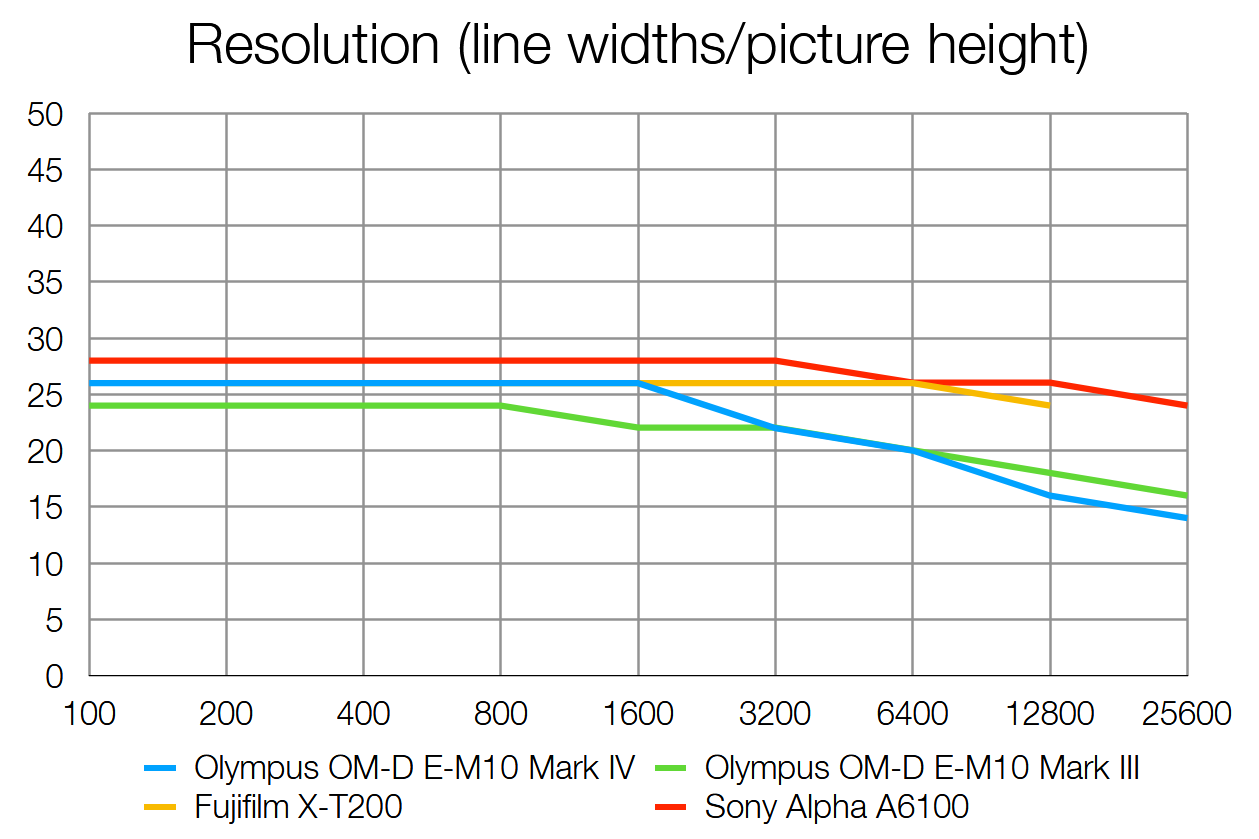
The move to a 20.3MP sensor has definitely given the E-M10 IV an advantage over its predecessor when it comes to resolving fine detail, and the new Olympus is even able to equal the 24MP Fujifilm X-T200 for detail capture at lower sensitivities. However, the E-M10 IV's smaller sensor and lower megapixel count can't match the image clarity from the Sony and Fujifilm cameras at higher ISOs.
Dynamic range:
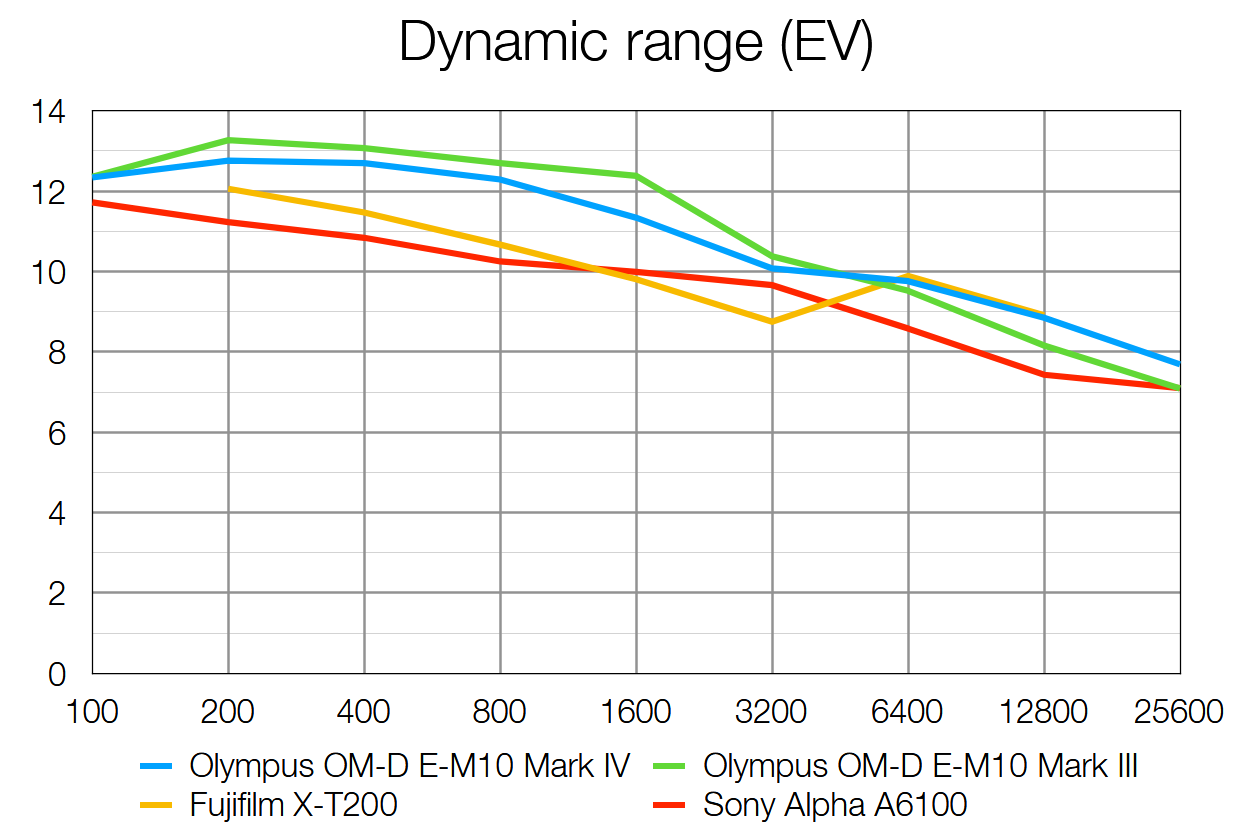
Olympus O-MD cameras have traditionally been strong for dynamic range, and the new E-M10 IV is no exception. While the old Mark III scores slightly better at lower sensitivities, things are reversed at ISO 6400 and above. Both Olympus cameras are capable of capturing significantly greater dynamic range than their rival APS-C cameras from Fujifilm and Sony. The X-T200's suspicious dynamic range increase at ISO 6400 is most likely due to automatic in-camera enhancement.
Signal to noise ratio:
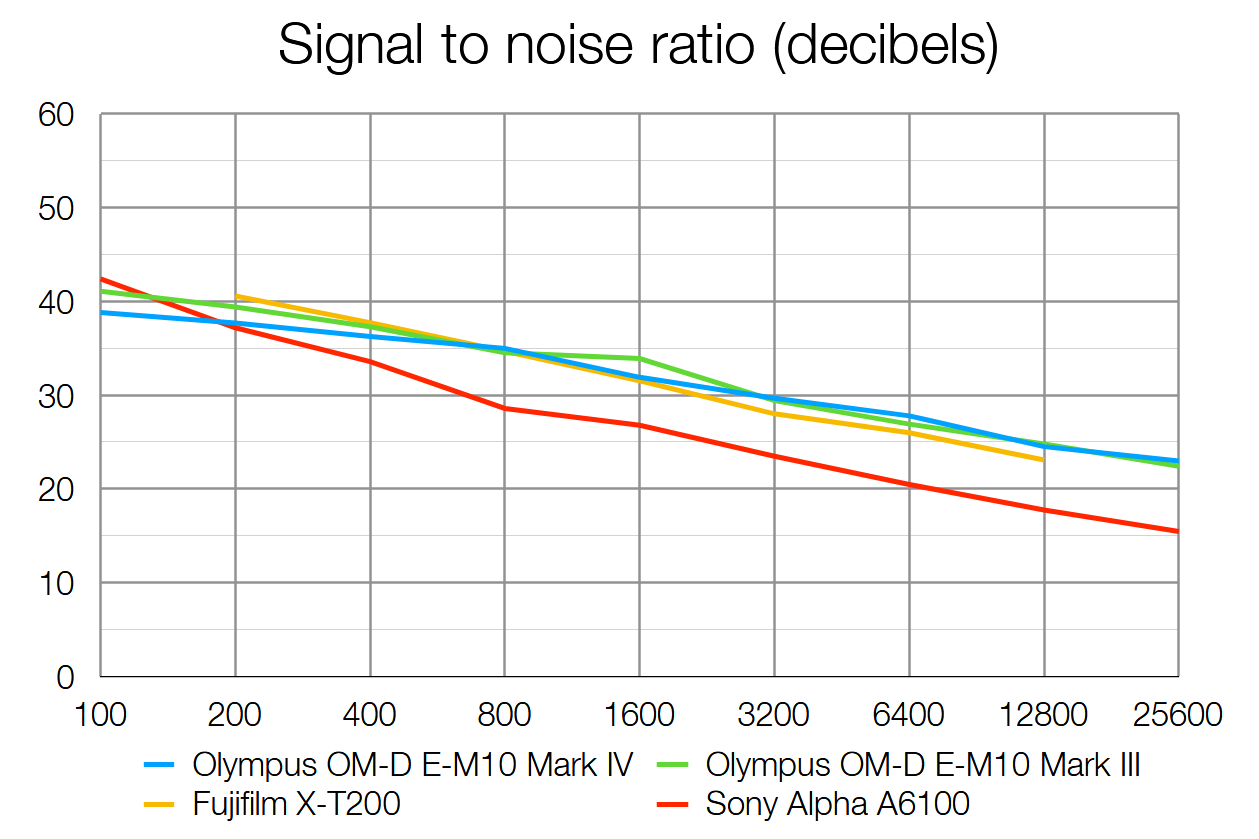
Our signal to noise test measures image clarity, specifically the ratio of the actual image 'data' you want to capture, versus the image noise that you don't want, but will inevitably be visible when shooting at higher ISO sensitivities. The higher the score at a given ISO sensitivity, the better.
An increase in megapixel count has the potential to increase image noise, as smaller pixels are usually less light-sensitive. However, Olympus has mostly managed to avoid this pitfall, as the E-M10 IV's images contain similarly low levels of image noise to those from the Mark III, and indeed the APS-C Fujifilm X-T200 for that matter. Sony's A6100 doesn't fare quite so well, with its images containing noticeably more noise at higher ISOs.
Olympus OM-D E-M10 Mark IV: Verdict
The Olympus OM-D E-M10 Mark IV is a fantastic little camera with plenty to offer. If we had any criticisms, it would be that we’d love to see a mic port to go along with the 4K video capabilities and flip down screen. This camera is fine for casual video, but for any serious vlogging or filmmaking, you'd probably be looking at the OM-1 line or one of the best vlogging cameras from Sony, Nikon or Fujifilm.
What the E-M10 Mark IV has over all these vlogging cameras, though, is an electronic viewfinder. This is becoming an increasing rarity on mirrorless cameras in this price bracket, and it cements this camera's appeal as a photographic tool, not just a vlogging camera.
The fact is, whether you’re a smartphone enthusiast looking to make the jump to a ‘proper’ camera, you want to capture high quality family snaps, or you’re simply searching for a lightweight camera to take with you on your travels, the OM-D E-M10 Mark IV could be the perfect camera for you, even now, four years on from its original launch.
Camera technology has veered strongly towards video in the past few years while the development of stills photography has slowed right down. If photography is your main interest, this four-year-old camera is as current today as it was back in 2020.
See our pick of the best lenses for the Olympus OM-D E-M10
| Features | 20MP, excellent IBIS, 4K video and an EFV – everything a beginner might need | ★★★★★ |
| Design | Compact and light, but with a great control layout, though the feel is a little plasticky | ★★★★☆ |
| Performance | Still image quality is good, as is the 4K video, though the AF and high-ISO image quality lag behind some modern APS-C rivals | ★★★☆☆ |
| Value | Is there a better beginner/budget camera on the market at this price? We don't think so | ★★★★★ |
✅ Buy it...
- If you want a small, light and affordable camera to learn about photography and video
- If you want to do lots of travelling with the minimum of kit
- If you already own some older Olympus/MFT kit and you're looking for an affordable upgrade
🚫 Don't buy it...
- If you're heavily into vlogging. The E-M10 IV can do it, but other more recent APS-C cameras are better
- If you're looking for sheer image quality. For that you need to step up to full frame and be ready with big bucks
- If you like sports and action – the E-M10 IV has a snappy burst mode but lacks phase detect AF
Alternatives
Canon EOS R100: Canon's cheapest APS-C mirrorless camera is even cheaper than the OM10 IV, and by some margin, though it's clearly built down to a price, doesn't have in-body stabilization and its video features are pretty limite. Read the full review...
Sony A6100: the new 'budget' model in the Sony A6000 range, with 4K video and an electronic viewfinder, but no in-body stabilization. Prices have fallen with time, so keep an eye open for bargains. Be aware, though, that the 16-50mm kit lens is no match for the 14-42mm lens sold with the OM-D E-M10 IV. Read the full review...
With over a decade of photographic experience, Louise arms Digital Camera World with a wealth of knowledge on photographic technique and know-how – something at which she is so adept that she's delivered workshops for the likes of ITV and Sue Ryder. Louise also brings years of experience as both a web and print journalist, having served as features editor for Practical Photography magazine and contributing photography tutorials and camera analysis to titles including Digital Camera Magazine and Digital Photographer. Louise currently shoots with the Fujifilm X-T200 and the Nikon D800, capturing self-portraits and still life images, and is DCW's ecommerce editor, meaning that she knows good camera, lens and laptop deals when she sees them.

